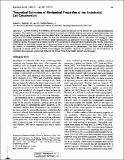Theoretical Estimates of Mechanical Properties of the Endothelial Cell Cytoskeleton
Author(s)
Satcher, Robert L. Jr.; Dewey, C. Forbes Jr.
DownloadSatcher-1996.pdf (1.208Mb)
Metadata
Show full item recordAbstract
Current modeling of endothelial cell mechanics does not account for the network of F-actin that permeates the
cytoplasm. This network, the distributed cytoplasmic structural actin (DCSA), extends from apical to basal membranes, with
frequent attachments. Stress fibers are intercalated within the network, with similar frequent attachments. The microscopic
structure of the DCSA resembles a foam, so that the mechanical properties can be estimated with analogy to these
well-studied systems. The moduli of shear and elastic deformations are estimated to be on the order of 10^5 dynes/cm^2 . This
prediction agrees with experimental measurements of the properties of cytoplasm and endothelial cells reported elsewhere.
Stress fibers can potentially increase the modulus by a factor of 2-10, depending on whether they act in series or parallel to
the network in transmitting surface forces. The deformations produced by physiological flow fields are of insufficient
magnitude to disrupt cell-to-cell or DCSA cross-linkages. The questions raised by this paradox, and the ramifications of
implicating the previously unreported DCSA as the primary force transmission element are discussed.
Description
Biophysical Journal, 1996
Date issued
1996Department
Massachusetts Institute of Technology. Department of Mechanical EngineeringPublisher
Biophysical Society
Citation
Biophysical Journal, 71, 109-118, (1996)
Keywords
distributed cytoplasmic structural actin, Endothelial Cell Cytoskeleton